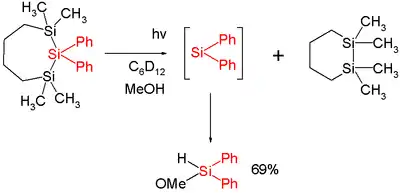Silylene
Silylene is a chemical compound with the formula SiH2. It is the silicon analog of methylene, the simplest carbene. Silylene is a stable molecule as a gas but rapidly reacts in a bimolecular manner when condensed. Unlike carbenes, which can exist in the singlet or triplet state, silylene (and all of its derivatives) are singlets.
 Simplest silylene has R=Hydrogen | |
 | |
| Names | |
|---|---|
| IUPAC name
Silylene | |
| Systematic IUPAC name
Silylidene[1] | |
| Other names
Hydrogen silicide(−II) Silicene | |
| Identifiers | |
3D model (JSmol) |
|
| ChemSpider | |
PubChem CID |
|
CompTox Dashboard (EPA) |
|
| |
| |
| Properties | |
| H2Si | |
| Molar mass | 30.101 g·mol−1 |
Except where otherwise noted, data are given for materials in their standard state (at 25 °C [77 °F], 100 kPa).
Infobox references | |
Silylenes are formal derivatives of silylene with its hydrogens replaced by other substituents.[2] Most examples feature amido (NR2) or alkyl/aryl groups.[3][4] Silylenes have been proposed as reactive intermediates. They are carbene analogs.[5]
Synthesis and properties
Silylenes are generally synthesized by thermolysis or photolysis of polysilanes, by silicon atom reactions (insertion, addition or abstraction), by pyrolysis of silanes, or by reduction of 1,1-dihalosilane. It has long been assumed that the conversion of metallic Si to tetravalent silicon compounds proceeds via silylene intermediates:
- Si + Cl2 → SiCl2
- SiCl2 + Cl2 → SiCl4
Similar considerations apply to the direct process, the reaction of methyl chloride and bulk silicon.
Early observations of silylenes involved generation of dimethylsilylene by dechlorination of dimethyldichlorosilane:[6]
- SiCl2(CH3)2 + 2 K → Si(CH3)2 + 2 KCl
The formation of dimethylsilylene was demonstrated by conducting the dechlorination in the presence of trimethylsilane, the trapped product being pentamethyldisilane:
- Si(CH3)2 + HSi(CH3)3 → (CH3)2Si(H)−Si(CH3)3
A room-temperature isolable N-heterocyclic silylene is N,N′-di-tert-butyl-1,3-diaza-2-silacyclopent-4-en-2-ylidene, first described in 1994 by Michael K. Denk et al.[7]

The α-amido centers stabilize silylenes by π-donation. The dehalogenation of diorganosilicon dihalides is a widely exploited.[8]
Related reactions

In one study diphenylsilylene is generated by flash photolysis of a trisilane:[9]
In this reaction diphenylsilylene is extruded from the trisila ring. The silylene can be observed with UV spectroscopy at 520 nm and is short-lived with a chemical half-life of two microseconds. Added methanol acts as a chemical trap with a second order rate constant of 1.3×1010 mol−1 s−1 which is close to diffusion control.
See also
- Carbene analogs
- N-heterocyclic silylene
- Silenes, R2Si=SiR2
- Silylium ions, protonated silylenes
References
- IUPAC Chemical Nomenclature and Structure Representation Division (2013). "P-71.2.2.1". In Favre, Henri A.; Powell, Warren H. (eds.). Nomenclature of Organic Chemistry: IUPAC Recommendations and Preferred Names 2013. IUPAC–RSC. ISBN 978-0-85404-182-4.
- Mizuhata, Yoshiyuki; Sasamori, Takahiro; Tokitoh, Norihiro (2009). "Stable Heavier Carbene Analogues". Chemical Reviews. 109 (8): 3479–3511. doi:10.1021/cr900093s. PMID 19630390.
- Nagendran, Selvarajan; Roesky, Herbert W. (2008). "The Chemistry of Aluminum(I), Silicon(II), and Germanium(II)". Organometallics. 27 (4): 457–492. doi:10.1021/om7007869.
- Haaf, Michael; Schmedake, Thomas A.; West, Robert (2000). "Stable Silylenes". Accounts of Chemical Research. 33 (10): 704–714. doi:10.1021/ar950192g. PMID 11041835.
- Gaspar, Peter; West, R. (1998). "Silylenes". The Chemistry of Organic Silicon Compounds. The Chemistry of Functional Groups. Vol. 2. pp. 2463–2568. doi:10.1002/0470857250.ch43. ISBN 0471967572.
- Skell, P. S.; Goldstein, E. J. (1964). "Dimethylsilene: CH3SiCH3". Journal of the American Chemical Society. 86 (7): 1442–1443. doi:10.1021/ja01061a040.
- Denk, Michael; Lennon, Robert; Hayashi, Randy; West, Robert; Belyakov, Alexander V.; Verne, Hans P.; Haaland, Arne; Wagner, Matthias; Metzler, Nils (1994). "Synthesis and Structure of a Stable Silylene". Journal of the American Chemical Society. 116 (6): 2691–2692. doi:10.1021/ja00085a088.
- Driess, Matthias; Yao, Shenglai; Brym, Markus; Van Wüllen, Christoph; Lentz, Dieter (2006). "A New Type of N-Heterocyclic Silylene with Ambivalent Reactivity". Journal of the American Chemical Society. 128 (30): 9628–9629. doi:10.1021/ja062928i. PMID 16866506.
- Moiseev, Andrey G.; Leigh, William J. (2006). "Diphenylsilylene". Journal of the American Chemical Society. 128 (45): 14442–14443. doi:10.1021/ja0653223. PMID 17090011.
